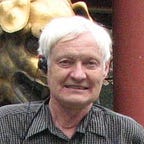The Perpetual Motion Machine
Today I found the description of a Perpetual Motion Machine on the internet, reproduced from a book of a Gardner D. Hiscox published in 1927, which works with communicating air bellows arranged on a wheel that is partly immersed in water. Here is a quote:
“Air transfer in submerged wheel. A, in the cut, is a tank containing water, as shown. The hollow arms, B, communicate with a hollow shaft, C, and the bellows, E, screw valves, D, being employed to increase or diminish the area of the passages in the hollow arms B.”
I recognized it at once as the invention of a man I met in a bar in Jerusalem, in 1979. He had intense eyes even in the dimness of the locale and seemed inquisitive by nature. After he found out that I was a physicist the man got all excited and asked my honest opinion about his idea. He went into great lengths explaining the principle, and why this machine, if properly constructed, was bound to produce an endless amount of energy. He even drew a sketch on a napkin. I told him in the friendliest way that this device, like many conceived before, would never produce a single watt. He took the news in stride, and I’m sure I was neither the first nor the last one whose professional opinion he sought. But when I asked to keep the napkin as a souvenir he strongly objected.
“Why should I give it to you? You’ll build it, and make a fortune,” he said.
I’m sure the news, if they ever reached him, that he was not the first to come up with the air transfer perpetual motion machine would make him even more upset than the realization it would never work.
